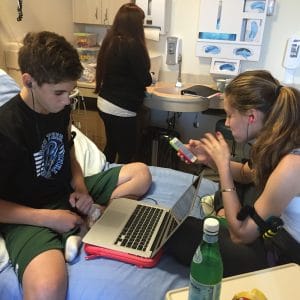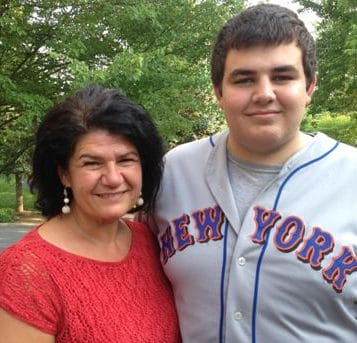 Amanda Palin
Amanda Palin Amanda Palin is a peanut-allergic teenager who has not only participated in more than one clinical trial, but also got a window into the world of food allergy research. Amanda got the rare opportunity to work for one of the world’s leading food allergy experts, Dr. Hugh Sampson.
It was not your average extracurricular activity. After gaining Sampson’s permission to volunteer as an intern, Amanda spent Thursday afternoons in the summer of 2016 after class in his research laboratory at the Icahn School of Medicine at Mount Sinai in New York City.
She collected blood samples and placed wearable patches on mice sensitized to be allergic. As part of the Viaskin “peanut patch” study, these tiny patches delivered small amounts of peanut protein to the animals.
“I had to hold the mice and put Nair [hair remover] on the animal to gain access to the skin. It was one of the weirdest things I’ve ever done,” Amanda notes with a laugh.
The research fascinates the young woman who has lived with a peanut allergy since she was 2 years old. Amanda herself has become a resilient veteran of human research to treat food allergy, as she has been determined to improve quality of life for herself and for other allergic kids and teens.
 Amanda with her brother, Ben, during a therapy.
Amanda with her brother, Ben, during a therapy. “In the sixth grade, I really hoped I wouldn’t have to go into college with my allergy to peanuts, because I know it causes social problems. At parties, I can’t eat or I have to bring my own food. And when you’re older, you have to be conscious about who you are kissing,” she says.
In 2010, she was a participant in a clinical study of a Chinese herbal therapy for food allergies, which was led by Mount Sinai’s Dr. Xiu-Min Li. “I had to take 10 herbal pills three times a day for six months,” Amanda says. However, it didn’t work for her allergy, and she ended her involvement.
But that didn’t dampen her enthusiasm to continue searching for answers to the mystery of food allergies. She enrolled in an oral immunotherapy (OIT) clinical trial, but unfortunately didn’t find the doses as easy to tolerate as some. “I was having reactions twice a week in my sophomore year of high school,” she says.
As a ballet dancer with an active and social lifestyle, the effects were taking a toll, and she ended up quitting the trial because of the impact on her quality of life. As for her allergy, “I was able to eat peanuts for a period of a year [during treatment], but my allergy came back.”
As Sampson has told Allergic Living in the past about patients like Amanda: “We often call them heroes. They’re willing to go through these therapies in the initial stages when we’re still trying to figure them out.”
The internship with the leading allergist, which she describes as one of the “most amazing experiences” of her life, has made Amanda more accepting of her food allergy. To understand what was happening to her body when she had an allergic reaction, she got behind the scenes and dove right into complicated research.
This fall, she began studying exercise science at Elon University in North Carolina, but says the medical field will remain very close to her heart. “I got to do so many things that I never even dreamed about doing. I definitely think I’ll be doing more work in an allergy lab.”
Amanda and her mother Roxanne Palin have also done considerable work to raise public awareness of food allergies. The pair was honored for their work at Food Allergy Research & Education’s annual New York spring luncheon in April 2017.
Read more:
Student Inventors Create Smartphone Case That Administers Epinephrine
Food Allergy Meets the Teenage Brain
The Major Lessons From My 3 Allergic Reactions





